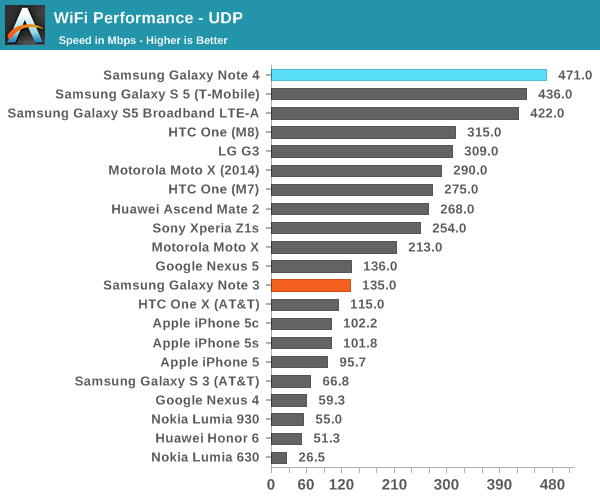The Samsung Galaxy Note 4 Review
by Joshua Ho on October 15, 2014 9:00 AM EST- Posted in
- Smartphones
- Samsung
- Android
- Mobile
- Galaxy Note 4
WiFi Performance
While the Galaxy S5 LTE-A Broadband had a Qualcomm Atheros solution (QCA6174), the Note 4 moves back to Broadcom's WiFi solution. In this case, we see the BCM4358, which is a revision of the BCM4354 that was first seen with Samsung's Galaxy S5. This shouldn't have any major differences outside of improved Bluetooth coexistence but antenna design can and does change between revisions. In order to test this, we use iperf and Asus' RT-AC68U router to try and achieve maximum performance.

As one can see, the Galaxy Note 4 has a strong showing in this test, easily surpassing every other device we have available for testing.
GNSS
At this point, it really goes without saying that the GNSS solution of choice is the one built into Qualcomm's modem. This allows for fixes based upon initial location and time data that the modem has, and therefore in practice every GPS fix is a hot fix and takes around 5 seconds for a lock in good conditions. In the case of the Note 4, with airplane mode on and no assistance data I saw that it took around 50 seconds to achieve a lock, but this is strongly dependent upon environmental conditions. Once locked, I found that the Note 4 had quite a strong lock and quickly went down to 10 foot accuracy level without issue.
Misc
Similar to the new Moto X we see a Cypress CapSense solution in the Note 4 but this is likely used for the capacitive buttons rather than any impedance-matching antenna tuner. The UV sensor appears to be a Maxim design win, although there's no information on the specific part. The battery's fuel gauge is also a Maxim part, as is the speaker amplifier and pulse sensor. The NFC chip used is NXP's PN547, so host card emulation should be supported and therefore Google Wallet's tap and pay system should work as well.











195 Comments
View All Comments
synaesthetic - Saturday, October 18, 2014 - link
Isn't that the whole point of using Android? I mean, it's kind of a trainwreck when OEM skins and carrier bloatware gets involved. If it wasn't for custom OS flashing I would probably be using a Jolla phone or hanging onto the old Nokia N9. Or just using an iPhone. I mean, if I can't tweak and customize, then my problem with iOS largely disappears.snake2332 - Wednesday, October 22, 2014 - link
That literally is the first thing I do, but I'm not average. However, do average consumers read anandtech? I think not, so there is some relevance to arguing against uhuznaa's statement since a fair amount of people won't be using the stock ROM at all.tralalalalalala40 - Friday, October 17, 2014 - link
So you want him to root the phone to get a proper test. That sounds like an accurate way to model the average consumer use. hasnake2332 - Wednesday, October 22, 2014 - link
Who cares about the average consumer here?seanlumly - Wednesday, October 15, 2014 - link
This review is good, but lacks discussion (or mention, for that matter) about Gear VR, a very significant first-step development in the world of mobile phones. If nothing else, VR may have an effect on the decisions surrounding critical hardware found in future mobiles.theduckofdeath - Wednesday, October 15, 2014 - link
I noticed that too. the Gear VR is actually one the toys I'm looking forward to the most over the next few months.seanlumly - Wednesday, October 15, 2014 - link
Me too! And while I'm looking forward to it, I'm confident that it is a bold and important step for the industry. It potentially adds an alternative to large-screen TVs that have become standard, and open up new ways of sharing information. More importantly, the mobile phone is so ubiquitous that this lowers the cost of VR significantly, and puts it into more hands.Such a thing deserves serious mention in a review of this device as its a serious development.
theuglyman0war - Monday, October 20, 2014 - link
if this is a petition for the interest in the future coverage of vr and phones strapped to my face with rubberbands then count me in pleeeze ( me to )firstever - Wednesday, October 15, 2014 - link
From the brightness tests, the display is 331 nits. How is the readability in the daytime? What does the auto boost do to make the display brighter?theduckofdeath - Wednesday, October 15, 2014 - link
With a contrast ratio of nearly 1,000,000:1 it has a dynamic range in the region of 1000 times better than any LCD display.That gigantic difference means that those miniscule differences in the specs sites like Anandtech always loves to focus on are pretty much irrelevant. I think it was GSM arena who made an visual comparison of outdoor readability on all major brands a few months ago, and even though the GS5 had around half the brightness of the "best" competitors, the GS5 was a lot more readable outdoors.
The adaptive brightness increased the outdoor brightness of something like 100 nits on older Samsung devices, I guess this is in the same region.